Annual Warm-Season Legumes for Florida and the US Gulf Coast: Forage Yield, Nutritional Composition, and Feeding Value1
High-quality forage legumes grown during the warm season are scarce in Florida and the Gulf Coast region. Temperate perennial forage crops, such as alfalfa (Medicago sativa), do not grow well in this region (Prine and French 1999). Although perennial (rhizoma) peanut (Arachis glabrata) grows well in this region, it is planted from rhizomes, takes two to three years to fully establish a stand, and is costly to establish. Seeded warm-season legumes, such as cowpea (Vigna unguiculata), soybean (Glycine max), and pigeonpea (Cajanus cajan), can be grown in the Gulf Coast region. These legumes are less expensive and faster to establish, and they could provide nutritious forage to complement beef cattle and other ruminant animal feeding programs.
Cowpea is a viney, low-growing plant with large leaves. Soybean (late maturity group) is an upright, bushy plant that is 4–6 feet in height. Pigeonpea grows tall and has a woody main stem and small leaves. Recommended maturities for forage harvest are when pods begin to turn yellow for cowpea, stage R6 (full-size seed in pods at one of the four uppermost nodes and completely unrolled leaves) for soybean, and pod setting for pigeonpea (Foster et al. 2009a).
The annual cultivated peanut (Arachis hypogaea) is another possible seeded legume for forage production in the Gulf Coast region. More information about the annual peanut as a forage crop can be found in the UF/IFAS Extension publication entitled The Annual Cultivated Peanut (Arachis hypogaea) as a Potential Forage Crop for Livestock in the Southeastern USA available on the UF/IFAS EDIS website (Myer et al. 2010).
Forage Yield and Nutrient Composition
For three consecutive years, cowpea ('Iron Clay'), forage soybean ('Pioneer 97B52'; VII maturity) and pigeonpea ('Georgia 2') were grown at the North Florida Research and Education Center in Marianna, Florida. The forages were planted in May of each year and were sampled bi-weekly starting when plants reached 12 inches in height. Sampling lasted until the three species reached recommended maturity stages that maximized yield and nutritive value.
Soybean and pigeonpea had greater forage dry matter yield than cowpea (Figure 1). Note that forage yield can vary greatly—not only due to species—but also due to variety within species, soil type and fertility, rainfall amount, weed pressure, etc.
Therefore, under most conditions, cowpea would yield 1–3 tons of forage (dry matter basis) per acre, and forage soybean and pigeonpea would yield about 2–6 tons (Foster et al. 2009a). For comparison, perennial peanut grown in the southeast United States typically yields 3–5 tons per acre (Prine and French 1999).

All three forage legumes had high crude-protein concentrations early in the growing season; however, crude protein of pigeonpea declined rapidly as the season progressed (Figure 2). Crude-protein concentrations held somewhat steady for soybean and cowpea forages as the season progressed (Figure 2). Likewise, all three legume forages had high in vitro true digestibility (IVTD) early in the growing season, but the values declined over time for pigeonpea (Figure 3). Digestibility held steady for soybean and cowpea as the season progressed (Figure 3). In vitro true digestibility is a laboratory procedure that simulates digestion in cattle and other ruminant animals (e.g., sheep and goats).
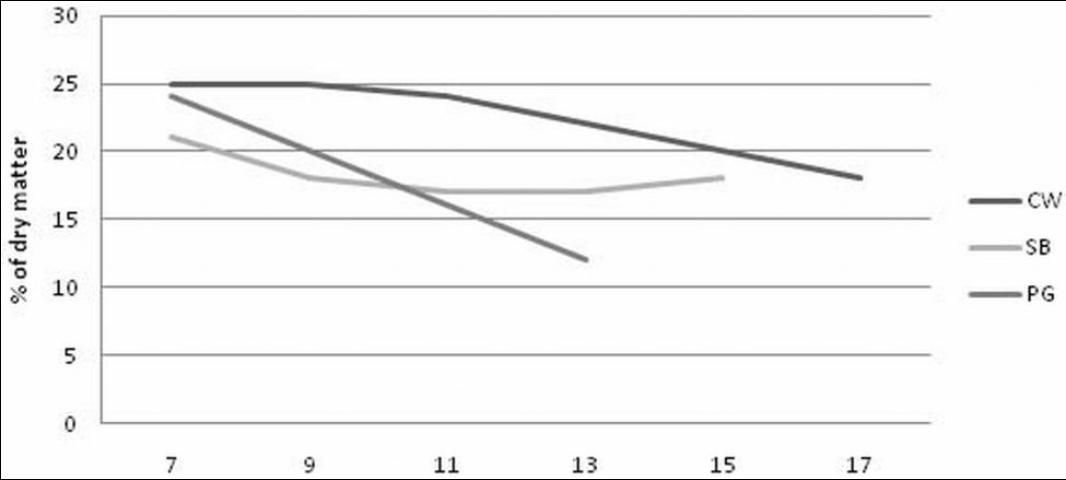
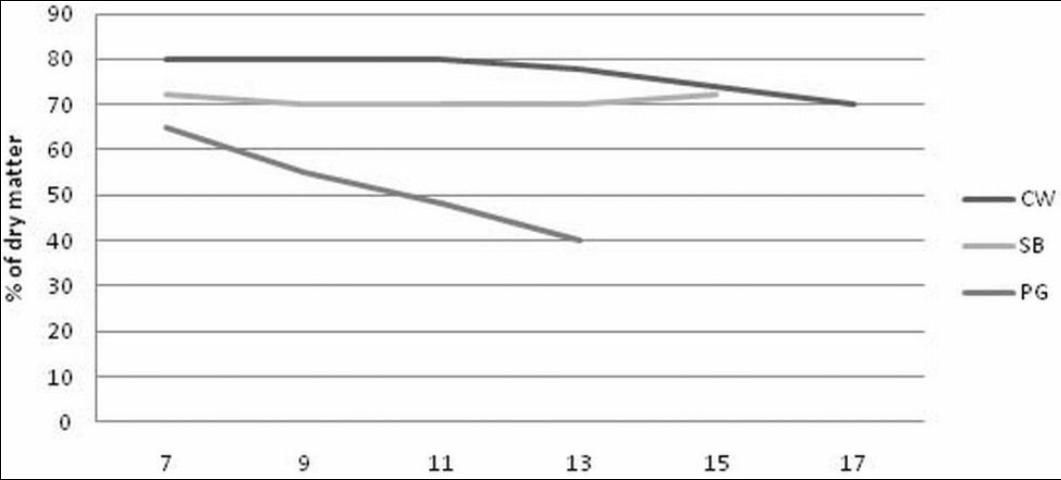
At final harvest at optimum maturity, average crude protein concentrations were higher and neutral detergent fiber (NDF) concentrations were lower for both cowpea and soybean forages than those obtained for pigeonpea (Table 1). The IVTD of cowpea and forage soybean averaged higher than that of pigeonpea (Table 1).
Florida Feeding Trials with Lambs
Two experiments were conducted to evaluate soybean, cowpea, and pigeonpea hays or haylages as supplements for lambs fed bahiagrass hay or haylage. Perennial peanut and annual peanut hays or haylages were also included in the trials. These legume forages were supplemented to a bahiagrass hay or haylage diet and compared with a diet of bahiagrass hay or haylage with no supplement or bahiagrass with supplementary soybean meal. Lambs were used because they are excellent models for examining supplementation effects in growing cattle.
The forages were harvested as hays for the first experiment in one year and as haylages for the second experiment the following year. Soybean haylage was not included in the second year because of crop failure. The hays and haylages were harvested as round bales, and haylages were wrapped in plastic at 45% moisture. Hays and haylages were chopped before feeding, mixed with chopped bahiagrass (50:50 blend; dry matter basis), and fed to the lambs. Dry-matter intake, dry-matter digestibility, crude-protein digestibility, and nitrogen retention (a measure of protein retained for growth) by the lambs were measured.
On a dry-matter basis, crude-protein concentrations in the legume hays ranged from 12% for pigeonpea and cowpea to 15% for perennial peanut and annual peanut (Table 1). Bahiagrass hay averaged 8% crude protein. Crude-protein concentrations of haylages were generally higher than concentrations of the hays. Crude protein ranged from 14% for pigeonpea haylage to 19% for annual peanut haylage (Table 1). Bahiagrass haylage averaged 9% crude protein. In vitro digestibility was highest for perennial and annual peanut, followed closely by cowpea and soybean; pigeonpea had the worst IVTD (Table 1).
Supplementation with all legume hays, except pigeonpea, resulted in increased dietary dry-matter intake (Figure 4), protein digestibility (Figure 6), and nitrogen retention (Figure 7) in the lambs. Protein digestibility and nitrogen retention were best when perennial peanut hay was supplemented. Diet dry matter digestibility increased only when perennial peanut hay was supplemented (Figure 5).
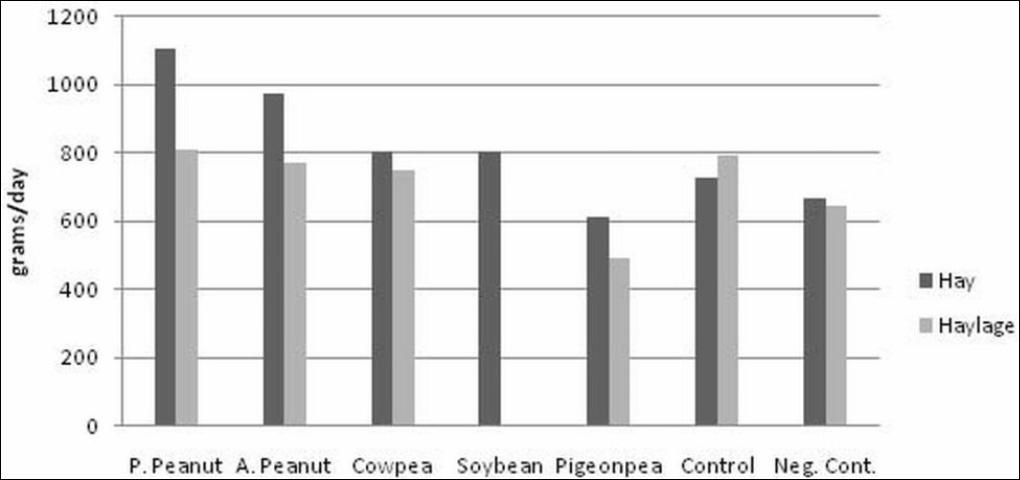
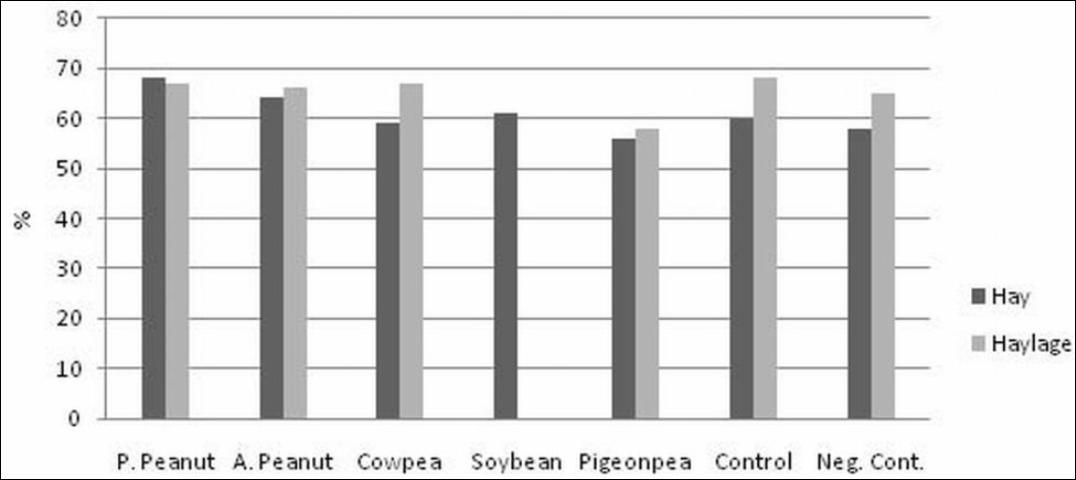
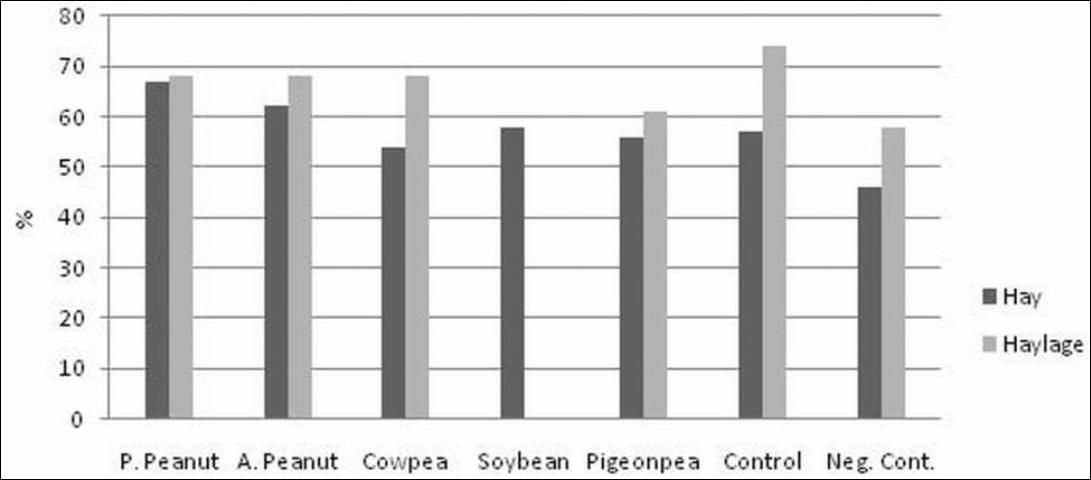
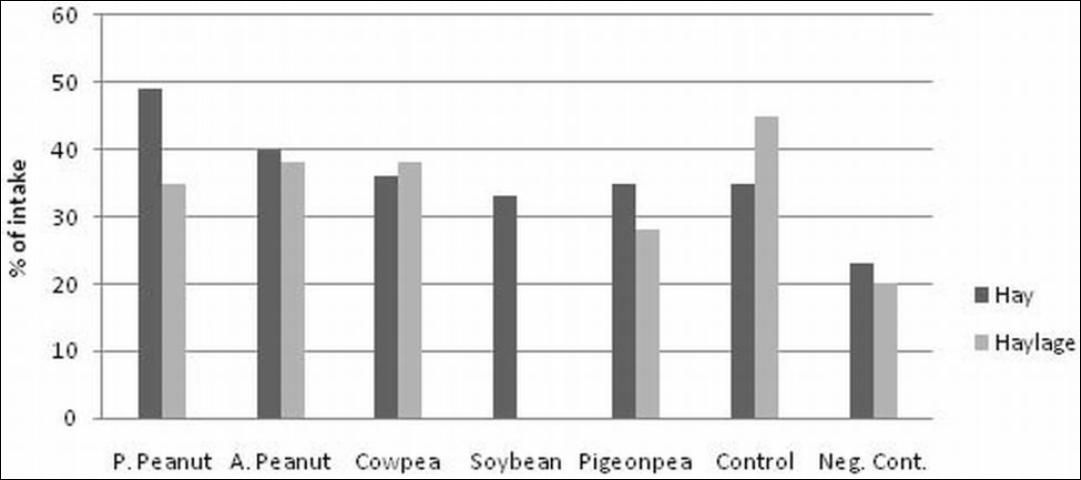
In the second experiment, supplementation with soybean meal or legume haylages, except pigeonpea, improved dry-matter intake (Figure 4), protein digestibility (Figure 6), and nitrogen retention (Figure 7) in the lambs. Only soybean meal supplementation (control) improved diet dry-matter digestibility (Figure 5).
Results of the two experiments indicate that perennial peanut, annual peanut, cowpea, and soybean hays and haylages were high-quality forages that improved intake, digestibility, and nitrogen retention when supplemented to bahiagrass hay or haylage. Pigeonpea hay and haylage performed poorly as supplements to bahiagrass.
Cowpea, Forage Soybean, or Pigeonpea?
Based on forage yield, nutritional composition, and results from the lamb experiments, soybean and cowpea have more potential as forages for ruminants than pigeonpea. However, as a forage, soybean did not regrow following defoliation; therefore, this legume would be best for providing large quantities of high-quality hay, silage, or haylage. The indeterminate growth habit and regrowth potential of cowpea would make it suitable for grazing and hay, silage, or haylage production. Because of its longer growing season and higher crude-protein concentration, especially late in the season, cowpea would be most suited to provide supplemental protein via grazing to cattle in the mid- to late-summer period, when the quality of perennial grasses typically declines. Pigeonpea should be harvested early or at a tall stubble height (about 15 in.) to improve its nutritional quality. Pigeonpea would provide excellent browsing for goats, deer, and sheep because of their ability to select the leaf tissue, which would contain adequate protein concentration and digestibility for their nutritional needs. All legumes grew well and had relatively high forage dry matter yields in the Marianna study, except when inadequate precipitation prevented emergence of soybean during the second year of the three-year study. In conclusion, soybean and cowpea are suitable substitutes for perennial peanut to provide high-quality forage to livestock in Florida and the Gulf Coast.
Related EDIS Publications
Myer, R. O., A. T. Adesogan, A. R. Blount, D. W. Gorbet, and B. L. Tillman. 2010. Annual Peanut (Arachis hypogaea L.) as a Potential Forage Crop for the Southeastern U. S. Gainesville: University of Florida Institute of Food and Agricultural Sciences. https://doi.org/10.32473/edis-an255-2010
Myer, B., L. Warren, J. Eckert, D. Hancock, A. Blount, and C. Olson. 2010. Perennial Peanut: Forage Nutritional Composition and Feeding Value. Gainesville: University of Florida Institute of Food and Agricultural Sciences. https://doi.org/10.32473/edis-an234-2010
Newman, Y. C., C. L. Mackowiak, A. R. Blount, and J. Ferrell. 2009. Perennial Peanut: A Quick Reference. Gainesville: University of Florida Institute of Food and Agricultural Sciences. https://doi.org/10.32473/edis-ag329-2009
Blount, A. R. S., D. L. Wright, R. L. Sprenkel, T. D. Hewitt, and R. O. Myer. 2009. Forage Soybeans for Grazing, Hay, and Silage. Gainesville: University of Florida Institute of Food and Agricultural Sciences. https://edis.ifas.ufl.edu/publication/ag184
Chambliss, C. G. and I. V. Ezenwa. 2006. Minor Use Summer Annual Forage Legumes. Gainesville: University of Florida Institute of Food and Agricultural Sciences. https://edis.ifas.ufl.edu/ag156
Other Related Publications
Foster, J. L., A. T. Adesogan, J. N. Carter, L. E. Sollenberger, R. O. Myer, A. R. Blount, and S. Phatak. 2009. "Warm-season Legume Hay or Soybean Meal Supplementation Effects on the Performance of Lambs." J. Anim. Sci. 87:2891–2898.
Foster, J. L., A. T. Adesogan, J. N. Carter, L. E. Sollenberger, R. O. Myer, A. R. Blount, and S. Phatak. 2009. "Warm-season Legume Haylage or Soybean Meal Supplementation Effects on the Performance of Lambs." J. Anim. Sci. 87:2899–2905.
Foster, J. L., A. T. Adesogan, J. N. Carter, L. E. Sollenberger, A. R. Blount, R. O. Myer, S. Phatak, and M. K. Maddox. 2009a. "Annual Legumes for Forage Systems in the United States Gulf Coast Region." Agron. J. 101:415–421.
Reference
Prine, G. M., and E. C. French. "New Forage, Grain and Energy Crops for Humid Lower South, US," in Perspectives on New Crops and Uses 1999, J. Janick edition, 60–65. Alexandria, VA: ASHS Press, 1999.


